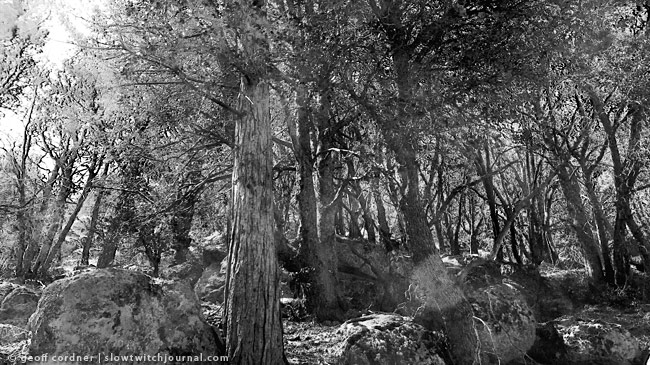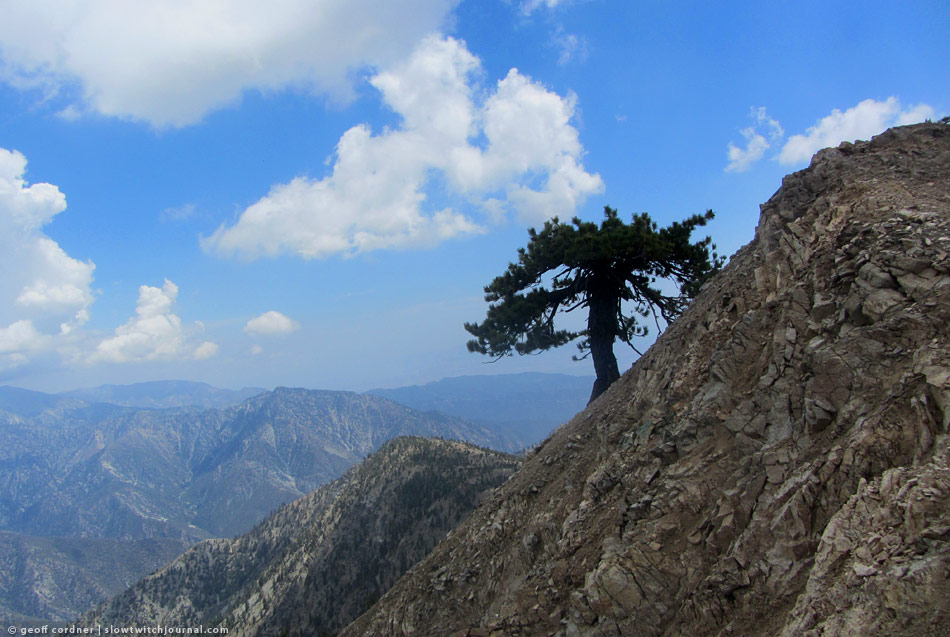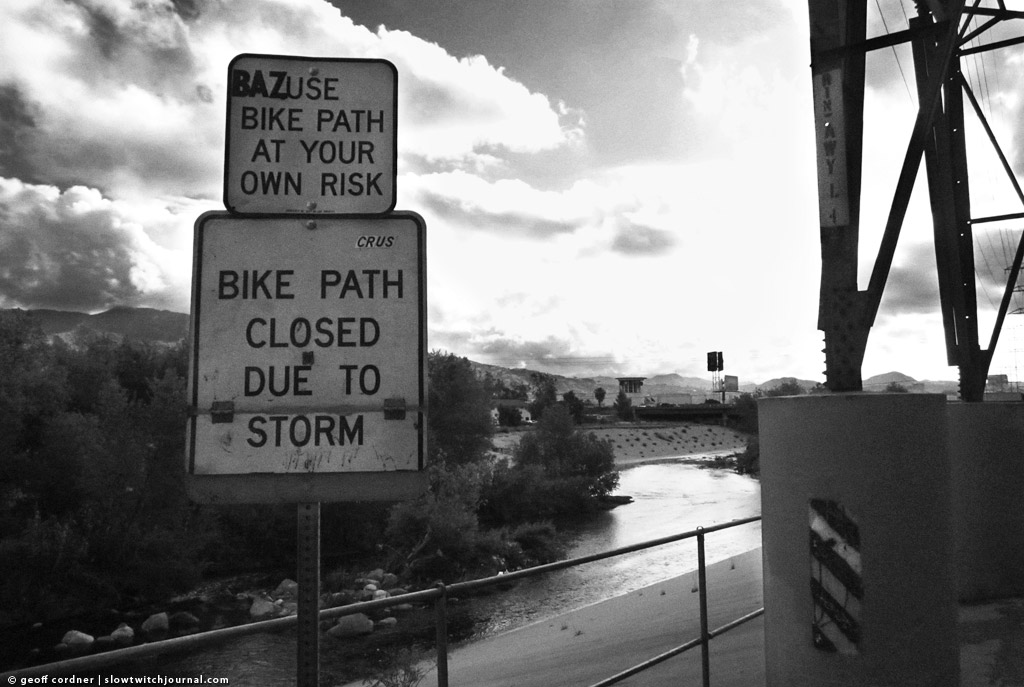Riverside Drive
Sunday. Still tired from yesterday’s dehydrating midday heat wave hill run through Griffith Park, today was a somewhat plodding 12.5 miler out my door, down the hill, Allesandro to Riverside to Fletcher, LA River bike path to the end and then some, back through Griffith Park and Riverside, with an official end at the bottom of the hill that, a steep 3/4 of a mile later, reaches my door. Walking that hill is a bitch on tired legs. Running it? Naw. The special part about this run is a mile long stretch of Riverside that I’d never run before, which means I got to see a coolly ghetto-ish chunk of my immediate neighborhood in a way I’d never seen it. This will be a camera run soon. I am now officially training again. I have decided that my foot is in good shape.
Wednesday. A tempo run, sorta, down the new and not-yet-opened part of the LA River Bikepath that goes through Frogtown. This was a nice run except for one thing: IT STANK. For real.
As I came to the end of the speed part, pretty much gasping for air, I hit the urinal cake factory, which wasn’t opened when I passed it heading out, and sucked in the lung, gut, nostril and serenity searing stench of stale urinals. I did not know how to react.
Reaction #1: get the fuck outta there and stop breathing in urinal cakes asap…but that means gasping for breath when the air is 50% ammonia.
Reaction #2: slow down, breath gently, ease away from the urinal cakes factory, but that means more time breathing ammonia.
Reaction #3: stand perfectly still while the gears in my brain are frozen due to indecision.
I cycled through the three responses in reverse order.
A few minutes later, game to try a slight detour, I ran through a raw sewage spill on Ripple. This was a morning of thoroughly unpleasant odors all related to human waste. Yikes. Aside from that, it was a pretty good run.





Is that from the new (to you) stretch of Riverside? I’ve been looking forward to your camera run/walk/trek of it. I used to live on the other side of the tracks as it were, in Glassell Park, so I crossed the 5 on Fletcher and then various segments of Riverside or the LA River path to get into Griffith or Elysian Park.
I love viewing your running routes this way, but it’s very different from reading about them. Words let you fill in with your own pictures. Photographs are like falling through the rabbit hole.
This shot is from last year, coming home from a bike ride. The stretch of Riverside is between Fletcher and Alessandro. There’s some great stuff I’ll shoot maybe this coming Wednesday, on the morning run.
The photos really are a study. I think maybe I’ve said that before. The idea is to teach myself to keep seeing the “same” thing in a new way, to understand that it’s not really the same thing after all, that there is a flow to reality and a flow to my perception, and that they are separate.
My relationship with LA has always been conflicted and pretty much dysfunctional. There are layers and layers and layers both to the city and to my relationship with it. When I take these photos I sort of engage in an insight meditation, and it helps – there’s more love and less hate to the love/hate dynamic when the camera gets involved.
Glassel Park huh? You’ve been all over, seems like. I like Glassel Park. I’m up in Elysian Heights.
You’ve said that before, but this is clearer — well clearer, but not clear. I think comprehension at this level can’t be achieved in two paragraphs or less, but that’s okay. I can be a patient learner, and I hope you’ll expand on it again as the study continues.
_I’ve_ been all over? Now I know you’re mocking me.
Mocking you? No. Seems like I’ve read posts from or about LA, Toronto, back and forth outta Santa Barbara, and why does Texas ring some kinda bell? All in what strikes me as a fairly short span of time. That’s movement by a lot of folks standards, including mine these days, as I seem to have taken root.
The flow of reality, flow of perception, and the often only coincidental meetings of the two are (in my understanding) basic Buddhist tenets, and I find my life is much better when I remember them. It takes work, though, or rather practice, because my natural inclination is to think of reality as fixed through time, and to confuse my perception of reality with reality itself. And when that happens, things tend to go awry in ways that are usually not so comfortable.
I think I get now what you meant about the involvement of the camera. When I look through the viewfinder, I’m reminded that what I see is not what the lens and film will see, and neither of these is fully descriptive of the reality out there. However, when the shutter snaps, all three exist simultaneously in that moment. It’s impossible to say whether my perception is truer than the film. Maybe both are equally true, or both false. In the next moment, reality can flow on, and all three are unlinked again. Is this part close to being right?
If I form my perceptions passively, it’s possible to keep them separate from reality, but if I act, aren’t they forced to meet? Of course the intersection will not be perfect, because any consequences will be filtered through my existing perceptions again, but in principle the outcome could either corroborate or contradict my perceptions. Unless I want to restrict my life to one of passivity then, shouldn’t I strive to bring my perceptions as close to reality as I possibly can? This is where it becomes murky; I think perception and reality should be distinct but related, and not separate.
You’ve got some of it, yeah.
Let’s forget about the camera and the photo and just talk about perception and reality. In order to answer you I sorta need to sum up Buddhism in a single blog comment, which I’m not really qualified to do – I’m not a teacher or much of a scholar when it comes to this subject. But I’ll give it a shot anyhow.
Reality. Impermanence. In Buddhism, impermanence is one of the three marks (or truths) of existence. Impermanence is kind of obvious. Everything changes, all the time, on micro and macro levels. Dilgo Rinpoche, an important 20th century Buddhist teacher, said “If you continue investigating, you will find that there is nothing anywhere, not even a single atom, that has a verifiable existence.” When you look at it that way, it starts to challenge a bit the way we are taught to think.
I think you get the change stuff, but you still have an idea of reality being fixed at any given instant, and that a photo or a perception can be an accurate (albeit incomplete) representation of what reality was in that instant. A Buddhist might tell you that what reality was or will be is not reality. Reality is only what is. Impermanence is not a quality of reality. It more or less is reality.
Perception. Buddhism holds that reality exists independent of any human conceptualization of it. What we experience – perception – is an interpretation of that reality. That approximation is based on concepts – subjective constructs – and a big part of what those concepts do is objectify. We see something and our mind clamps down on it, turns it into an object, segregates it from the rest of existence: that is a flower or that is a dog…
I’m gonna paraphrase from a book called “Buddhism is Not What You Think”. The title is a pun, and the pun is kind of important. The Buddha said there are two types of knowledge. One he called knowing accordingly: knowing what things look like, sound like, appear to be. Knowing accordingly involves ideas, concepts, surface appearance of seemingly separate things. It takes place in the realm of objects, separation, this & that – a fractured view of the world.
Reality is dynamic, undulating, ever-changing, and cannot be understood by knowing accordingly.
So using that Buddhism-in-a-nutshell, there is no truth to perception when perception is of the knowing-accordingly variety, and this is said to be the cause of suffering.
I’m not sure I understand what you mean by passive perception. Buddhist practice doesn’t promote resignation and defeatism and agrees with your striving “to bring my perceptions as close to reality as I possibly can.” A goal of Buddhist practice is to end suffering, and since suffering is caused by grasping & craving, the way to end suffering is not to back off into a world of passivity and resign yourself to never having the things you crave. In Buddhist practice (as I’ve learned it) this involves striving to leave behind “knowing accordingly” and penetrate surfaces, discarding the grasping attachment to subjective constructs, and seeing the impermanence and flow. This penetration is said to be the second type of knowing. There’s a specific meditation practice – Vipassana, or mindfulness – that is all about this.
That was quite a comment, deserving of some time and proper digestion. I think you were polite to say that I understood any part of your earlier statements, especially how the camera figures in your meditation. I see now that is too personal a process for me to comprehend, so I’m relieved you put that aside.
I think you are talking about a reality that is one level deeper than where I was working from. The common use of the word ‘reality’ is of a fixed concept, but we rest on it because it’s convenient. It’s a kind of shorthand for navigating the physical world in order to meet basic needs. Like mama coyote, it’s useful to be able to identify a car, a human, a dog, and attribute behaviours to them when it’s time to hunt. Even if these behaviours are quite unpredictable and dynamic, for the purpose of getting around and fed, it’s a conceptual crutch that does the job. There may or may not be any truth in these perceptions, but truth takes a back seat to utility. The way I used the word ‘perceiving’ is more or less sensing. You can sense passively by observing, hearing and smelling what comes your way, but your conceptual crutch will be much more useful if you interact with your environment to learn about it.
At this point, I think we can agree that mastering a concept of your physical environment will probably help you survive and maybe avoid physical discomfort, but is wholly unsatisfying as a way to exist.
The reality that I think you mean, might also be described as the essence of a unified existence. The sensations we do receive and any conscious interpretation of them may or may not have any bearing on this essential reality, but it cannot be perceived fully via those means alone. As a non-Buddhist, I can’t speculate on how to perceive it or the spiritual consequences of doing so, but it’s a familiar idea. There is even a mathematical equation of quantum physics which shows that mystery is intrinsic to the nature of the universe.
Within the field of physics there’s a considerable diversity of opinion regarding the limits of knowing accordingly to borrow your terminology, partly because of that equation, and other findings which defy human ability to conceptualise their meaning. Einstein himself died rejecting some principles of quantum mechanics that are directly responsible for the CCD in your camera. However, there is general agreement that when we debate these questions we do so as seekers, with no special standing. For myself, I believe physics and more broadly science, is fundamentally ill-equipped to fathom the profoundest questions. Occasionally physics produces ideas of tremendous elegance and beauty, which I experience not very differently from art. Like art, a resemblance to reality is irrelevant in the moment.
As a professional practitioner of knowing accordingly, I can’t say I feel particularly burdened by suffering as Buddhist teachings might suggest. However, I also think suffering can have value. We may have to agree to differ on this issue until an opportunity arises to discuss it further.
When trying to express so much within the confines of a blog comment, there’s a risk that I come off sounding much more absolute about things than is appropriate.
Couple of things (maybe three):
Yes, human concepts, etc. are a shorthand that’s convenient and maybe even necessary for communicating & navigating our way through the world, especially the manmade parts of the world, since we’ve built it out of those concepts and symbols. The trick is to remember what they are and not to mistake them for universal truths.
With regards to knowing accordingly: I didn’t mean to suggest that every instance of knowing accordingly leads to suffering. Instead, it’s that instances of suffering likely comes from knowing accordingly.
“Suffering” is the most commonly used but not really a very good translation of the original Pali word Dukkha. Other translations are “intolerable”, “unsustainable”, “difficult to endure”, “imperfect”, “unsatisfying”, or “incapable of providing perfect happiness”…a “deep subtle sense of unsatisfactoriness”…
Oooo, I like your elaboration of suffering, which sounds morbid, but I mean it in the best possible way. It rounds the concept of knowing accordingly, and crystallises for me what you mean by reality. It’s true. I practise knowing accordingly every day, and I love what I do, but it has all of those negative qualities as well. Full circle to love/hate again. It’s not quite a confusion of science for reality, or that I inflate its importance; my impression is that the mind wasn’t meant to be so narrowly engaged in objective thinking. No doubt why I run so much.
I’m sorry I derailed your post into another continent, but only a little because I learned so much from this discussion! Thanks for taking the time to teach.